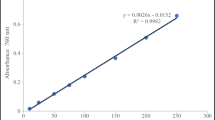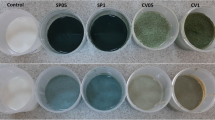Abstract
Microbial, chemical, physical, and sensorial analyses of kefir samples produced using kefir grains embedded with Gluconacetobacter spp. were investigated using kefir samples with Gluconacetobacter spp. inclusion (KA), and regular kefir grains (control, KC) lacking Gluconacetobacter spp. The genus Gluconacetobacter, (identified using PCR) isolated from apple cider vinegar, was embedded in kefir grains. Inclusion of Gluconacetobacter spp. provided a significant biomass increase (p<0.01). The Lactobacillus spp., Lactococcus spp., yeast, Lactobacillus acidophilus, and Bifidobacterium spp. contents of KA were similar to KC. The acetic acid bacterial content of KA was 3.86 log CFU/mL. A significant (p<0.05) increase was observed in the exopolysaccharide content and viscosity of KA compared with KC. Inclusion of a different useful bacterium not naturally present in kefir grains is herein reported. Kefir grains can be an important carrier for microorganisms.
Similar content being viewed by others
References
Ottogalli G, Galli A, Resmini P, Volonterio G. Composizione microbiologia, chimica ed ultrastruttura dei ganuli di kefir. Annali. Di. Microbiolgia 23: 109–121 (1973)
Garrote GL, Abraham AG, De Antoni GL. Chemical and microbiological characterization of kefir grains. J. Dairy Res. 68: 639–652 (2001)
Farnworth ER. Kefir-a complex probiotic. Food Sci. Technol. Bull. Funct. Foods 2: 1–17 (2006)
Güzel-Seydim ZB, Kök-Tas T, Greene AK, Seydim, AC. Review: Functional properties of kefir. Food Sci. Nutr. 51: 261–268 (2011)
Budak NH, Aykin E, Seydim, AC, Greene AK, Guzel-Seydim ZB. Functional properties of vinegar. J. Food Sci. 79: 57–64 (2014)
De Ory I, Romeo LE, Cantero D. Optimum starting-up protocol of a pilot plant scale acetifier for vinegar production. J. Food Eng. 52: 31–37 (2002)
Swings I. The Genera Acetobacter and Gluconobacter. In: The Prokaryotes. Balows A, Triiper HG, Dworkin M, Harder W, Schleifer KH (eds). Springer, New York, NY, USA. pp. 2268–2286 (1992)
Franke HI, Fegan M, Hayward C, Graham Leonard G, Stackebrandt E, Sly LI. Description of Gluconacetobacter sacchari sp. nov., a new species of acetic acid bacterium isolated from the leaf sheath of sugar cane and from the pink sugar-cane mealy bug. Int. J. Syst. Bacteriol. 4: 1681–1693 (1999)
Nishikawa Y, Takata Y, Nagai Y, Mori T, Kawada T, Ishihara N. Antihypertensive effects of korusu extract, a traditional vinegar produced from unpolished rice, in the SHR rats. Nippon. Kagaku. Kaishi. 48: 73–75 (2001)
Costa AO, Thomaz-Soccol V, Paulino RC, Castro AE. Effect of vinegar on the viability of Giardia duodenalis cysts. Int. J. Food Microbiol. 128: 510–512 (2009)
Fukami H, Kobayashi S, Tachimoto H, Kishi M, Kaga T, Waki H, Iwamoto M, Tanaka Y. Effect continuous ingestion of acetic acid bacteria on memory retention and the synaptic function in aged rat. Biosci. Biotech. Bioch. 74: 1498–1500 (2010)
Oda T, Tachimoto H, Kishi M, Kaga T, Ichihash M. Effect of oral intake of ceramide-containing acetic acid bacteria on skin barrier function. Anti-Aging Med. 7: 50–54 (2010)
Irigoyen A, Arana I, Castiella M, Torre P, Ibanez FC. Microbiological, physicochemical, and sensory characteristics of kefir during storage. Food Chem. 90: 613–620 (2005)
Da Cruz Pedrozo Miguel MG, Gomes Cardoso P, de Assis Lago L, Schwan RF. Diversity of bacteria present in milk kefir grains using culture-dependent and culture-independent methods. Food Res. Int. 43: 1523–1528 (2010)
Budak HN, Guzel Seydim ZB. Antioxidant activity and phenolic content of wine vinegars produced by two different techniques. J. Sci. Food Agr. 90: 2021–2026 (2010)
Fernández Pérez R, Torres C, Sanz S, Ruiz Larrea F. Rapid molecular methods for enumeration and taxonomical identification of acetic acid bacteria responsible for submerged vinegar production. Eur. Food Res. Technol. 231: 813–819 (2010)
Trcek J, Toyama H, Czuba J, Misiewicz A, Matsushita K. Correlation between acetic acid resistance and characteristics of PQQ-dependent ADH in acetic acid bacteria. Appl. Microbiol. Biotech. 70: 366–373 (2006)
Kök-Tas T, Ekinci Y, Güzel-Seydim ZB. Identification of microbial flora in kefir grains produced in Turkey using PCR. Int. J. Dairy Technol. 65: 126–131 (2012)
Guzel-Seydim Z, Kök-Taş T, Ertekin B, Seydim, AC. Effect of fat replacers on biomass increase in kefir grains. J. Dairy Sci. 94: 1239–42 (2011)
Mossel DAA, Corry JEL, Stuijk CB, Baird RM. Essential of the Microbiology of Food: A Texbook for Advance Studies. John Wiley & Sons, Chichester, UK. pp. 224–227 (1995)
Özer, BH, Uzun YS, Kirmaci HA. Effect of cell immobilization on viability of Lactobacillus acidophilus LA-5 and Bifidobacterium bifidum BB-12 in Kasar cheese. Int. J. Dairy Technol. 61: 237–244 (2008)
Marquina D, Santos A, Corpas I, Munoz J, Zazo J, Peinado JM. Dietary influence of Kefir on microbial activities in the mouse bowel. Appl. Microbiol. 35: 136–140 (2002)
AOAC. Official Method of Analysis of AOAC Intl. 16th ed. Official Methods of Analysis (OMA). Association of Official Analytical Communities, Arlington, VA, USA (1996)
Zisu B, Shah NP. Effects of pH, temperature, supplementation with whey protein concentrate, and adjunct cultures on the production of exopolysaccharides by Streptococcus thermophilus 1275. J. Dairy Sci. 86: 3405–3415 (2003)
Cerning J, Bouillanne C, Landon M, Desmazeaud M. Isolation and characterization of exopolysaccharides from slime forming mesophilic lactic acid bacteria. J. Dairy Sci. 75: 692–699 (1973)
Ertekin B, Guzel Seydim ZB. Effect of fat replacers on Kefir quality. J. Sci. Food Agr. 90: 543–548 (2010)
Coggins PC, Schilling MW, Kumari S, Gerrard PD. Development of a sensory lexicon for conventional milk yogurt in the United States. J. Sens. Stud. 5: 671–687 (2008)
The Basic Local Alignment Search Tool. BLAST finds regions of similarity between biological sequences. Available from: http://www.ncbi.nlm.nih.gov/BLAST/Blast.cgi. Accessed Jun. 18, 2011.
Yang Z, Zhou F, Ji B, Li B, Luo Y, Yang, L, Li T. Symbiosis between Microorganisms from Kombucha and Kefir: Potential Significance to the Enhancement of Kombucha Function. Appl. Biochem. Biotech. 160: 446–455 (2010)
Valepyn E, Berezina N, Paquot M. Optimization of production and preliminary characterization of new exopolysaccharides from Gluconacetobacter hansenii LMG1524. Adv. Microbio. 2: 488–496 (2012)
Kök Taş T, Seydim AC, Özer B, Guzel-Seydim ZB. Effect of different fermantation parameters on quality characteristics of kefir. J. Dairy Sci. 92: 780–789 (2013)
Guzel-Seydim, ZB, Seydim AC, Greene AK. Turkish kefir and kefir grains: Microbial enumeration and electron microscopic observation. J. Int. Dairy Technol. 58: 25–29 (2005)
Park JK, Jung JY, Park YH Cellulose production by Gluconacetobacter hansenii in a medium containing ethanol. Biotechnol. Lett. 25: 2055–2059 (2003)
Wang Y, Li C, Liu P, Ahmed Z, Xiao P, Bai X. Physical characterization of exopolysaccharide produced by Lactobacillus plantarum KF5 isolated from Tibet Kefir. Carbohyd. Polym. 82: 895–903 (2006)
Dutta D, Gachhui R. Nitrogen-fixing and cellulose-producing Gluconacetobacter kombuchae sp. nov., isolated from Kombucha tea. Int. J. Syst. Evol. Micr. 57: 353–357 (2007)
Tratnik L, Rajka B, Herceg Z, Draglic I. The quality of plain and supplemented kefir from goat’s and cow’s milk. Int. J. Dairy Technol. 59 (2006)
Babina NA, Rozhokova IV. Quantitative composition of Kefir grains and Kefir microflora at different of the year. Food Chem. 2: 15–17 (1973)
Libudzisz Z, Piatkiewicz A. Kefir Production in Poland. Dairy Ind. Int. 55: 31–34 (1990)
Witthuhn RC, Schoeman T, Britz TJ. Isolation and characterization of the microbial population of different South African Kefir grains. Int. J. Dairy Technol. 57: 33–37 (2004)
Author information
Authors and Affiliations
Corresponding author
Rights and permissions
About this article
Cite this article
Özdemir, N., Kök-Taş, T. & Guzel-Seydim, Z. Effect of Gluconacetobacter spp. on kefir grains and kefir quality. Food Sci Biotechnol 24, 99–106 (2015). https://doi.org/10.1007/s10068-015-0015-1
Received:
Revised:
Accepted:
Published:
Issue Date:
DOI: https://doi.org/10.1007/s10068-015-0015-1




